Archive for the ‘globalization’ Tag
Hacking the Middle East
Simplistic pronouncements about the role of social media in stirring uprisings and toppling dictators have by now, thankfully, seemed to die down. That Facebook, Twitter, YouTube and other digital tools have been important to the historic upheaval in the Middle East is an unimpeachable fact. And a closer look at how those tools played a part is more than just interesting — it may offer clues to major social and political movements of the future.
A gathering last week in San Francisco organized by Hacks/Hackers and HackDemocracy showcased some illuminating work on the subject. Stanford computer scientist Rio Akasaka shared an animation he made showing worldwide Twitter activity from Feb. 7 to 14 that used the hashtag #Egypt. Unsurprisingly, the United States and Europe figure most prominently in the dynamic constellation, but there was also a climactic surge across the Middle East, South Asia and South America as news spread on Feb. 11 that Hosni Mubarak no longer held power:
Each dot on the map, Akasaka said, represents a single tweet; at the peak of activity for #Egypt, he said, there were as many as 6,000 per minute.
After the Mubarak regime all but shut down the Internet in Egypt at the end of January, activists moved to work around the technological assault. Egyptians relied even more on mobile phones to connect to the outer world, said Ahmed Shihab-Eldin of Al Jazeera English, in some cases texting and emailing trusted contacts elsewhere in the Middle East or Europe who would disseminate the info via Facebook, Twitter and blogs. Meanwhile, Google and Twitter joined forces to launch speak2tweet, a service that helped Egyptian citizens keep information flowing online by way of voicemails.
Egyptian-born technology entrepreneur Amir Khella said that the R.N.N news hub on Facebook, which reportedly saw a veritable explosion of page views in late January, was the best “hack” he’d seen among any related to the revolution. The R.N.N page pulled together information via text messages, phone calls and emails from people witnessing various events on the ground. R.N.N would crosscheck multiple reports from the same approximate time and location, Khella said, in order to separate fact from rumor. (Who exactly is behind R.N.N remains unclear, he later told me.) It was a nimble kind of crowdsourcing born of the crisis.
No doubt there have been other useful applications of digital technology during this period of seismic change in the Middle East, and surely more will spring up in the months ahead. It’s also important not to overstate their role, and to examine how the Internet has been used nefariously by oppressive regimes.
Maybe in part it’s because the earlier proliferation of Facebook and Twitter in American culture was marked by some frivolity that writers such as Malcolm Gladwell haughtily dismissed them as a sideshow in the context of revolutions. (See Matthew Ingram for a sharp take on how Gladwell went astray.) But as the speakers last week in San Francisco reiterated, a great number of people in the Arab world are using them, and not primarily to muse about what they ate for lunch. Under pressure from the U.S. government, executives at Facebook and Twitter have made moves to keep their platforms viable for activists, and it’s doubtful that their motivations to do so were solely capitalistic.
“We realize that in order to be meaningful, online freedoms must carry over into real-world activism,” said Secretary of State Hillary Clinton in February, in a wide-ranging speech about Internet freedom. She later continued: “The dramatic increase in internet users during the past 10 years has been remarkable to witness. But that was just the opening act. In the next 20 years, nearly 5 billion people will join the network. It is those users who will decide the future.”
WikiLeaks might make America safer
[Updates to this post, through Monday Dec. 13, follow below.]
When the “Afghan war logs” became public earlier this year, I focused on WikiLeaks from the standpoint of its huge impact on the media. The ongoing release of a quarter million State Department cables has since unleashed a torrent of hot debate about government secrecy and whether Julian Assange’s organization is a force for good or evil.
Like many others, I’ve marinated myself in related articles and commentary over the last week but remain ambivalent about some of the complex moral issues involved. I’ve also been pondering a question that seems noticeably absent from the discussion: Could it be that WikiLeaks is actually the best thing in a long time to afflict U.S. national security?
The cacophonous phenomenon on the world’s front pages has been a grand wake-up call — the rise of cyberwar is no longer a matter of theory. It’s here whether you believe Assange is an enemy or a hero. If it proves true that a low-level Army analyst was able to get his hands on such a colossal amount of sensitive documents, what does that say about Pentagon preparedness for the security challenges of the proliferating information age?
So far some contents of “cablegate” itself have informed our view of just how serious an issue this is. As the Times reported on Sunday, “repeated and often successful hacking attacks from China on the United States government, private enterprises and Western allies” have been taking place since as far back as 2002. One previously unreported attack “yielded more than 50 megabytes of e-mails and a complete list of user names and passwords from an American government agency.”
The China cables also show the fire with which WikiLeaks plays; you get the sense that if some of the redacted names were revealed, it could potentially be disastrous, both to individuals involved and to U.S. intelligence gathering.
It’s noteworthy that the Obama administration’s assessment of the damage from WikiLeaks has consistently been inconsistent. The latest round has Attorney General Eric Holder saying that “national security of the United States has been put at risk,” while Defense Secretary Robert Gates says that concerns about potential harm are “significantly overwrought” and that the disclosures will have a “fairly modest” impact on foreign policy. The mixed message would seem to suggest that the U.S. government yet lacks a coherent approach to safeguarding the nation’s information infrastructure.
In the later years of the Bush administration, the federal government began to prioritize cyberwar, a focus continued by the Obama administration. But today there are the troubling, all too familiar signs of unpreparedness, agency turf wars and legal muddle. The Pentagon’s Cyber Command seeks to expand its powers aggressively and is, not coincidentally, publicizing that fact now. According to the Washington Post, its general in charge recently testified to Congress that he could not adequately defend the country against cyber-attack because it “is not my mission to defend today the entire nation.” If an adversary attacked power grids, he said, a defensive effort would “rely heavily on commercial industry.” Former national intelligence director Dennis C. Blair warned, “This infuriating business about who’s in charge and who gets to call the shots is just making us muscle-bound.”
By some accounts the world hasn’t seen anything yet in terms of the looming dangers of cyberwar. An attack could cripple America, argues former counterterrorism chief Richard Clarke, striking everything from train routes and electrical grids to bank data and medical records.
WikiLeaks over the last few months, then, may have exposed U.S. government vulnerability in an alarmingly useful way, if one not much in line with Assange’s ideas about undermining state power. You can bet it has lit a serious fire under officials involved with the nation’s cybersecurity, who now must be working that much more intensively to plug any leaks in the ship of state and build up defenses against future attacks. They are, of course, likely toiling in secrecy. For now, anyway.
UPDATE: On the eve of his arrest in London, Assange publishes an article in The Australian: “Don’t shoot messenger for revealing uncomfortable truths.” He opens with a quote from Rupert Murdoch: “In the race between secrecy and truth, it seems inevitable that truth will always win.”
UPDATE 12/8/10: Hackers sympathetic to Assange and WikiLeaks have launched a series of cyberattacks in recent days, targeting MasterCard, PayPal and a Swiss bank. (Could Twitter be next?) The Guardian looks into the “shadowy group” allegedly behind the attacks:
A 22-year-old spokesman, who wished to be known only as “Coldblood”, told the Guardian that the group – which is about a thousand strong – is “quite a loose band of people who share the same kind of ideals” and wish to be a force for “chaotic good”.
There is no real command structure in the group, the London-based spokesman said, while most of its members are teenagers who are “trying to make an impact on what happens with the limited knowledge they have”. But others are parents, IT professionals and people who happen to have time – and resources – on their hands.
It’s really too bad that Stieg Larsson isn’t still around to witness all this.
Also: Some incisive comments at the cross-posted version of my piece on MoJo from Matthew Rotando on the implications of escalating cyberwar.
And: A great primer on WikiLeaks and roundup of coverage from Alexis Madrigal at The Atlantic.
 UPDATE 12/13/10: The WikiLeaks saga itself continues to ratchet up the potential for cyberwar. With a secret grand jury in Virginia reportedly now considering criminal charges against Assange, a headline in today’s Daily Mail raises the specter of retribution for Assange’s potential extradition: “Britain on cyber warfare alert as Whitehall prepares for WikiLeaks revenge attacks on Government website, it reads. Apparently “bank details of taxpayers and benefits claimants” could be at risk.
UPDATE 12/13/10: The WikiLeaks saga itself continues to ratchet up the potential for cyberwar. With a secret grand jury in Virginia reportedly now considering criminal charges against Assange, a headline in today’s Daily Mail raises the specter of retribution for Assange’s potential extradition: “Britain on cyber warfare alert as Whitehall prepares for WikiLeaks revenge attacks on Government website, it reads. Apparently “bank details of taxpayers and benefits claimants” could be at risk.
Stateside, meanwhile, the Times’ Scott Shane reports movement on the cyberwar front: “Whether or not the Obama administration tries to prosecute those who disseminated the information, it is determined to use technology to preserve its secrets. The Defense Department is scaling back information sharing, which its leaders believe went too far after information hoarding was blamed for the failure to detect the Sept. 11 plot. The department has also stripped CD and DVD recorders from its computers; it is redesigning security systems to require two people, not one, to move large amounts of information from a classified computer to an unclassified one; and it is installing software to detect downloads of unusual size.”
Love in the time of Terror Babies
“My parents, with admirable foresight, had their first child while they were on fellowships in the United States. My mother was in public health, and my father in a library-science program. Having an American baby was, my mother once said, like putting money in the bank.”
So begins Daniel Alarcón’s recently published short story “Second Lives,” whose narrator is a Latin American man with a potent longing for a First World life. His dream has eluded him; he realizes he is doomed to a “terminal condition” of Third World citizenship, despite that his older brother — the one lucky to be born on U.S. soil — had seized the opportunity to emigrate many years prior.
Alarcón is a writer I’ve long admired, in part for how he weaves complex cultural politics into quietly powerful narratives. (His luminous story collection War by Candlelight is a must-read.) “Second Lives” arrived with uncanny timing in this politically boiling August. At face value, its opening easily could be another rallying cry for the political far right, members of which have been stirring up anti-immigrant and anti-Muslim hysteria from California to Texas to lower Manhattan.
Even by today’s standard of partisan politics, the hot wave of demagoguery hitting the country feels off the charts. Take the fear mongering of Louie Gohmert, the Texas congressman who has been flogging the “terror babies” conspiracy on national television: Shadowy foreigners are plotting to give birth in the U.S., only to take their tots overseas, train them as terrorists and send them back decades later, courtesy of the 14th Amendment, to wreak havoc inside the country.
That this theory is plainly ridiculous, and has been debunked by FBI and U.S. Customs officials, is beside the point. As Ruben Navarrette Jr. wrote from Phoenix, this is political opportunism of a very scary kind.
You might say that Gohmert is just small potatoes. But what about more influential Republicans eager this election season to foment a crusade against Islam? The tactics aimed at the so-called “Ground Zero mosque” — which in name is pure invention — are no less craven. Newt Gingrich put a Hitlerian stamp on the proposed Muslim center in lower Manhattan: “Nazis don’t have the right to put up a sign next to the Holocaust museum in Washington,” he said by way of egregious comparison on Fox News. No doubt Gingrich is pleased to be in lockstep with the cowardly Anti-Defamation League; he could scarcely do more to exploit fearful support from Jews than to evoke the Holocaust.
There seems to be not a shred of empathy or basic human decency in this dark political campaign. Oh, sure, some agitators will say that some of their best friends are Muslims — which should ring about as true and logical as pronouncements on CNN by Bryan Fischer of the American Family Association: “I love Muslims, I am pro-Muslim. I am anti-Islam. I would say to a Muslim, ‘Look, your ideology is destructive, it’s deceptive, it’s dark.'” Or as Fischer also put it: “Islam is not a religion of peace. It is a religion of war, it is a religion of violence.”
In this war, Gingrich, Boehner and Cantor are the generals, the Fischers their captains on the ground. For them anything goes in the battle for congressional power this fall, the rising dangers of nativist provocation be damned.
Which returns me to Alarcón’s story. Against the multitude in the media recently (no shortage of fictions among them) it is an unwavering prick of light. It brims with the humanism that America’s darkly cartoonish politicos so palpably lack. As great fiction should, the story never directly grapples with the Big Political Issues, like immigration. Indeed, the politics here are personal, etched in the lives of characters coping with family struggle, romantic heartbreak and the daily challenges and amusements of assimilation. “Second Lives” is a portrait of a divided family gazing across the chasm between the Third and First Worlds — and it is a vivid reminder of what is really in the hearts and minds of the vast majority of America’s immigrant hopefuls.
“In school,” recalls Alarcón’s narrator, “my favorite subject was geography. Not just mine, it should be said.” He continues:
I doubt any generation of young people has ever looked at a world map with such a powerful mixture of longing and anxiety; we were like inmates being tempted with potential escape routes. Even our teacher must have felt it: when he took the map from the supply closet and tacked it to the blackboard, there was an audible sigh from the class. We were mesmerized by the possibilities; we assumed every country was more prosperous than ours, safer than ours, and at this scale they all seemed tantalizingly near. The atlas was passed around like pornography, and if you had the chance to sit alone with it for a few moments you counted yourself lucky. When confronted with a map of the United States, in my mind I placed dots across the continent, points to mark where my brother had lived and the various towns he’d passed through on his way to other places.
That dream of “other places,” of course, has everything to do with the greatness on which our immigrant-rich society has been built. The demagogues who have forgotten this truth, or who knowingly have traded it for the miasma of deranged politics, would do well to read and ponder Alarcón’s tale. It is so much taller, as it were, than any of theirs.
WikiLeaks exposed
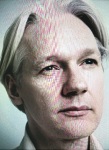 No matter where you come down on the veracity, morality or impact of WikiLeaks’ mountainous Afghan “war diary,” its release has been a fascinating event. It prompted me to reread Raffi Khatchadourian’s first-rate New Yorker profile of WikiLeaks founder Julian Assange, where several passages have fresh resonance in the wake of the latest document dump. (Back in April WikiLeaks made waves when it released a controversial video showing an attack by a U.S. Apache helicopter in Baghdad that killed seven people including two journalists.) There’s been much debate since Sunday, not to mention pushback from the White House, about whether WikiLeaks’ disclosures endanger U.S. troops and allies. Assange takes a provocative stance in this regard. As Khatchadourian reported back in early June:
No matter where you come down on the veracity, morality or impact of WikiLeaks’ mountainous Afghan “war diary,” its release has been a fascinating event. It prompted me to reread Raffi Khatchadourian’s first-rate New Yorker profile of WikiLeaks founder Julian Assange, where several passages have fresh resonance in the wake of the latest document dump. (Back in April WikiLeaks made waves when it released a controversial video showing an attack by a U.S. Apache helicopter in Baghdad that killed seven people including two journalists.) There’s been much debate since Sunday, not to mention pushback from the White House, about whether WikiLeaks’ disclosures endanger U.S. troops and allies. Assange takes a provocative stance in this regard. As Khatchadourian reported back in early June:
I asked Assange if he would refrain from releasing information that he knew might get someone killed. He said that he had instituted a “harm-minimization policy,” whereby people named in certain documents were contacted before publication, to warn them, but that there were also instances where the members of WikiLeaks might get “blood on our hands.”
Also widely discussed right now is the idea of WikiLeaks as a kind of roguish champion of transparency — one that is itself frustratingly, if perhaps necessarily, opaque. Khatchadourian also considered this problem in striking terms: “Soon enough, Assange must confront the paradox of his creation: the thing that he seems to detest most — power without accountability — is encoded in the site’s DNA, and will only become more pronounced as WikiLeaks evolves into a real institution.”
I highly recommend reading the full profile if you haven’t; Assange’s personal background and various perspectives are quite illuminating with regard to the global splash his organization currently is making.
Another major theme since Sunday has been the story’s impact on media itself. Without a doubt we are in an evolutionary moment. Jay Rosen has some great thoughts on the ramifications of WikiLeaks’ rise: “In media history up to now,” he says, “the press is free to report on what the powerful wish to keep secret because the laws of a given nation protect it. But Wikileaks is able to report on what the powerful wish to keep secret because the logic of the Internet permits it. This is new. Just as the Internet has no terrestrial address or central office, neither does Wikileaks.”
There’s another aspect of the freshly tweaked media equation that I find fascinating: How effectively Assange and his (unknown) collaborators played a bunch of prominent global news institutions in the service of their cause. Why did they give the trove of so-called war logs to the New York Times, the Guardian and Der Spiegel first, rather than just release all the raw material for anyone to dive into from the get-go?
 “It’s counterintuitive,” Assange explained in October 2009. “You’d think the bigger and more important the document is, the more likely it will be reported on but that’s absolutely not true. It’s about supply and demand. Zero supply equals high demand, it has value. As soon as we release the material, the supply goes to infinity, so the perceived value goes to zero.”
“It’s counterintuitive,” Assange explained in October 2009. “You’d think the bigger and more important the document is, the more likely it will be reported on but that’s absolutely not true. It’s about supply and demand. Zero supply equals high demand, it has value. As soon as we release the material, the supply goes to infinity, so the perceived value goes to zero.”
It’s certainly no coincidence that three media giants (from countries with troops in the war zone) were offered the embargoed material; WikiLeaks could bet that the New York Times wasn’t going to pass on it knowing that the Guardian or Der Spiegel might well produce a big exposé (and vice versa). You can sense the effect of this calculation bristling beneath comments from New York Times executive editor Bill Keller about his organization’s subsequent reporting project:
First, The Times has no control over WikiLeaks — where it gets its material, what it releases and in what form. To say that it is an independent organization is a monumental understatement. The decision to post this secret military archive on a Web site accessible to the public was WikiLeaks’, not ours. WikiLeaks was going to post the material even if The Times decided to ignore it.
Keller also noted: “At the request of the White House, The Times also urged WikiLeaks to withhold any harmful material from its Web site.”
By which Rosen further points out: “There’s the new balance of power, right there. In the revised picture we find the state, which holds the secrets but is powerless to prevent their release; the stateless news organization, deciding how to release them; and the national newspaper in the middle, negotiating the terms of legitimacy between these two actors.”
Here are some additional pieces to the WikiLeaks/Afghanistan story that are well worth checking out:
• Amy Davidson with a thoughtful take on the huge trove of raw information: “WikiLeaks has given us research materials for a history of the war in Afghanistan. To make full use of them, we will, again, have to think hard about what we are trying to learn: Is it what we are doing, day to day, on the ground in Afghanistan, and how we could do it better? Or what we are doing in Afghanistan at all?”
• Philip Shenon discussing the WikiLeaks phenomenon on “Fresh Air”: “You certainly hear at the Pentagon, at the White House, concern that one of these days somebody is going to leak something really important to an organization like Wikileaks. The example given to me is American nuclear secrets or the whereabouts of Osama bin Laden. Would Wikileaks put that out to the world without much filtering, and isn’t there a threat in that?”
• Steven Aftergood, a respected voice on government secrecy, noting that WikiLeaks represents a creative solution to “over-control of government information” — but ultimately blasting WikiLeaks as being “among the enemies of open society because it does not respect the rule of law nor does it honor the rights of individuals.”
• The WikiLeaks “about” page, which offers some bold declarations of purpose: “In an important sense, WikiLeaks is the first intelligence agency of the people. Better principled and less parochial than any governmental intelligence agency, it is able to be more accurate and relevant. It has no commercial or national interests at heart; its only interest is the revelation of the truth. Unlike the covert activities of state intelligence agencies, WikiLeaks relies upon the power of overt fact to enable and empower citizens to bring feared and corrupt governments and corporations to justice.”
Here’s the main page for the New York Times series.
And you can follow WikiLeaks activity on Twitter. (Bio: “We open governments.”)
UPDATE 7/28/10:
Forget the dismissive Pentagon Papers comparison that’s becoming conventional wisdom — see this sharp analysis from Joel Meares at CJR on the value of the Afghanistan docs: “The WikiLeaks documents put an underreported war back on the nation’s radar. It doesn’t matter that the pundits are yawning.”
Also now on CJR: Clint Hendler traces in detail how the WikiLeaks docs made their way into the Times, Guardian and Der Spiegel, “from Brussels, to a bunker, to blockbusters.” Part of his reporting underscores my view above as to how Assange played his hand with the three powerhouse news outlets:
On June 22, during a six hour coffee-soaked meeting in a Brussels café, Davies [a Guardian reporter] says Assange suggested another idea — that The Guardian and The New York Times be given an advance look at some information the site had on the Afghanistan war, with each paper publishing their own takes on the documents. Within the next twenty-four hours, Davies says Assange told him Der Spiegel should be included as well.
The piece recounts the unusual, highly secretive collaboration between the three news outlets that followed, as well as differing views on Assange’s involvement in the process. It’s an intriguing read that answers some questions while raising others — not only about how a rather mysterious new media force drove a global news cycle, but also about how things will go down when WikiLeaks makes its next move to foment a “global revolution,” as it puts it, in government and institutional accountability.
UPDATE 7/29/10:
Some commentators have suggested that the WikiLeaks story essentially was over after a couple days. Far from it, judging by the reaction of U.S. officials.
Speaking at a Pentagon press conference on Thursday, Defense Secretary Bob Gates said that the disclosures had “potentially dramatic and grievously harmful consequences,” including for Afghans identified in the documents who had helped the U.S. war effort. Added Admiral Mike Mullen, chairman of the joint chiefs of staff: “Mr. Assange can say whatever he likes about the greater good he thinks he and his source are doing, but the truth is they might already have on their hands the blood of some young soldier or that of an Afghan family.” (It’s interesting that Mullen seemed to refer to Assange’s source as a single person.) Meanwhile, the Justice Department apparently is looking into possible espionage charges against Assange and his organization. (That may be a stretch.) And Assange has said that WikiLeaks has another 15,000 unreleased Afghan war documents in its possession.
Postcard from Vancouver
A few snapshots from the final weekend here at the 2010 Winter Games.
The Olympic Cauldron at the convention center in downtown Vancouver, early Saturday evening:
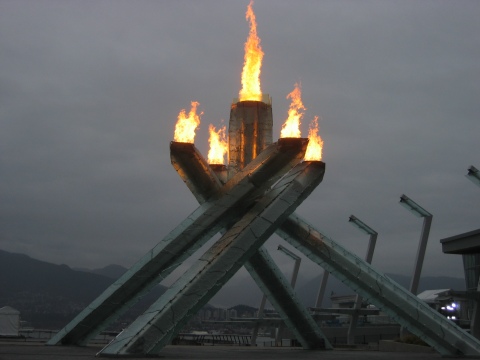
The Olympic Rings on a barge just off Stanley Park in Coal Harbour, early Saturday evening. Every time Canada won a medal, the Rings changed color for a little while accordingly, to gold, silver or bronze.
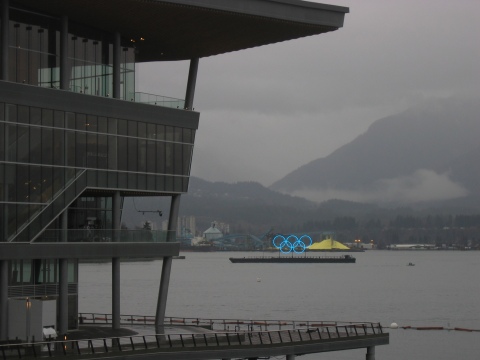
 By mid morning on Sunday, every single drinking establishment in the downtown area had a line around the block in anticipation of Canada facing off against the United States in the hockey gold medal finale. Some people were offering $100 just for a guaranteed spot to watch the game… in a bar. On Saturday night, some tickets to the game for sale online apparently were going for as much as $10,000.
By mid morning on Sunday, every single drinking establishment in the downtown area had a line around the block in anticipation of Canada facing off against the United States in the hockey gold medal finale. Some people were offering $100 just for a guaranteed spot to watch the game… in a bar. On Saturday night, some tickets to the game for sale online apparently were going for as much as $10,000.
A building at Georgia and Burrard streets draped in the Canadian flag:

Vancouver is an international city on a normal day, but for the past couple of weeks has transformed into a truly global village, with legions here from all over the world. It’s been fun just to walk the streets and mingle with the excited and friendly (and youthful) masses:
Bonus question: Is it really true that Russian skater Victor Plushenko was once an American rock star?
“Bluetoothing” Iran’s revolution
Though it’s grabbing fewer headlines these days, the upheaval in Tehran that began last summer continues to simmer. Apparently the Obama administration has some evolving ideas about how to exploit the domestic dissatisfaction, which has been rising, along with the local price of tomatoes, for quite some time. How long can Ahmadinejad hold on?
I finally had a chance to read Nazila Fathi’s recent essay about her experiences reporting from, and then fleeing from, Iran, where she’d been working for the New York Times. It’s chilling at turns, but also uplifting, particularly with its focus on the regime-busting role that technology has played in the historic unrest. Last summer I focused at length here on the unprecedented ways in which digital technology was shaping events from Tehran to Tiananmen Square. With events in Iran, Twitter suddenly had gone from trendy social networking toy to subversive diplomatic tool square on the State Department’s radar. But until reading Fathi’s essay I hadn’t known about another fascinating technological application in the fight—the use of Bluetooth by dissidents to dodge the crackdown. As Fathi writes of Iran’s continuing unrest in December:
Last month, during and after the funeral of the reformist Grand Ayatollah Hossain Ali Montazeri, one of the demonstrators’ most useful tools was the Bluetooth short-range radio signal that Americans use mainly to link a cellphone to an earpiece, or a printer to a laptop. Long ago, Iranian dissidents discovered that Bluetooth can as easily link cellphones to each other in a crowd. And that made “Bluetooth” a verb in Iran: a way to turn citizen reportage instantly viral. A protester Bluetooths a video clip to others nearby, and they do the same. Suddenly, if the authorities want to keep the image from escaping the scene, they must confiscate hundreds or thousands of phones and cameras.
The authorities have tried to fight back against such techniques and the Internet itself, but have fallen short. In November they announced that a new police unit, the “cyber-army,” would sweep the Web of dissent. It blocked Twitter feeds for a few hours in December, and an opposition Web site. But other blogs and Web sites mushroomed faster than the government could keep up.
Also be sure not to miss Frontline’s compelling documentary on the infamous killing of Neda Agha-Soltan.
UPDATE, 1/28/10: According to the New York Times, Iran reportedly has just executed two men in connection with the election protests. Nine others have been condemned to death for same.
The “Mcfarthest” spot, mass air traffic and a Minnesota-size memory
I’ve always loved maps. They reward the longer gaze. Especially in these digitally frenetic times. Whether depicting authentic truths or questionable claims, or one of many shades in between, they tend to provoke expansive thinking about the world. Or they zoom you in on something unexpected and compelling. Their borders inherently are porous to the imagination. And they can be just plain cool to look at — hand me a copy of Oxford’s Atlas of the World and I’ll be entertained for a healthy chunk of time flipping through those oversized pages. No iPhone necessary.
Of course, digital media allow mapmakers and collectors to take things to a next level. The Strange Maps blog is one great place to browse. A recent post featured the work of blogger Stephen Von Worley, who decided to chart America as fast-food dystopia by depicting McDonald’s ubiquity from coast to coast. The nagging question that was his point of departure: What’s the “McFarthest” one can possibly get from a Big Mac? Unsurprisingly, not very far at all, even in the relatively unpopulated West:

According to Von Worley’s calculations (per the summary at Strange Maps):
There are over 13,000 McDonald’s restaurants in the U.S., or about 1 for every 23,000 Americans. But even market penetration this advanced doesn’t mean that McDonald’s is everywhere. Somewhere in South Dakota is the McFarthest Spot, the place in the [continental] U.S. geographically most removed from the nearest McD’s. If you started out from this location, a few miles north of State Highway 20 (which runs latitudinally between Highways 73 in the west and 65 in the east), you’d have to drive 145 miles to get your Big Mac. (If you could fly, however, it’d be only 107 miles).
If you did decide to fly, you’d be contributing to some incredibly congested air traffic, especially if it’s during daylight. See this nifty depiction of 24 hours worth of planes flying the global skies:
Also worth watching is this feat of mapmaking by Senator Al Franken, who from memory composed one of the United States (while taking questions, no less) at the Minnesota State Fair:
Now if he and his comrades could only draw up a health care plan with such facility…
The spirit of Haida Gwaii
In late August I returned to the archipelago of Haida Gwaii, a place whose ancient, complex culture and astonishing natural beauty are inextricable. Earlier this week, in the village of Old Massett, the renowned Haida artist Robert Davidson hosted an epic two-day celebration commemorating the totem pole he carved here 40 years ago. The pole was raised in the village on August 22, 1969, replanting a vital Haida tradition that had nearly disappeared by the end of the 19th century. It was a privilege and joy to attend the festivities and to participate in documenting them. Here are a few images I captured (please do not reproduce them without permission), though they only begin to suggest the layers of landscape, art and ceremony that were on display.
The many performers included singers, drummers and dancers from Skidegate:

Spruce-root woven and painted hats filled the community hall:

The Tsimshian group Git-hoan, or People of the Salmon, were among the guests invited to perform:

Eagle Transformation Mask, carved by Robert Davidson and danced publicly for the first time by the Rainbow Creek Dancers:
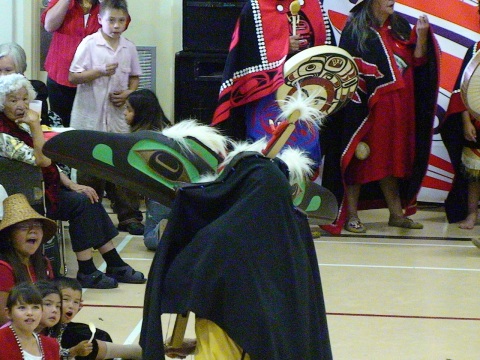

Robert Davidson’s 40-foot Bear Mother pole (partial view), raised in Old Massett in August 1969:
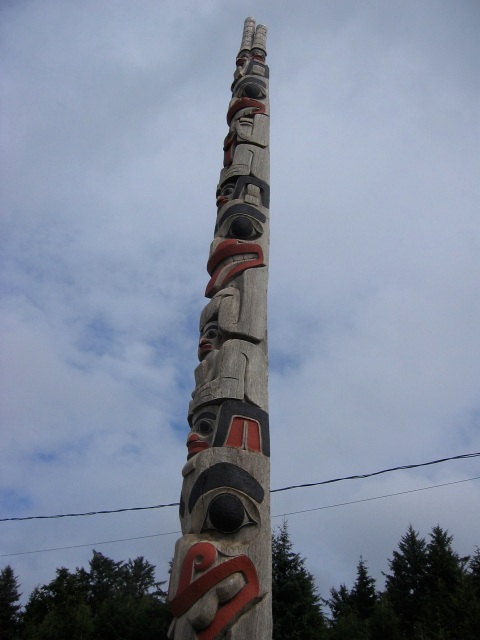
Despite devastation from decades of industrial logging, some majestic old trees still stand on Haida Gwaii. (Thanks to the tireless efforts of local advocates and defenders, the land increasingly has come under protection in recent years.) The temperate rain forests are home to towering cedar, hemlock and spruce:
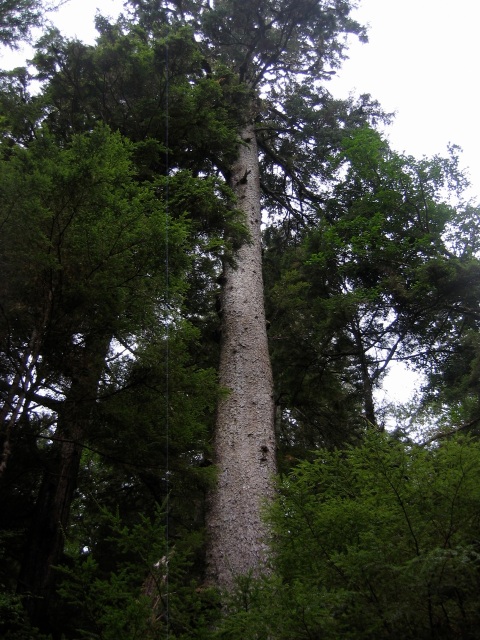
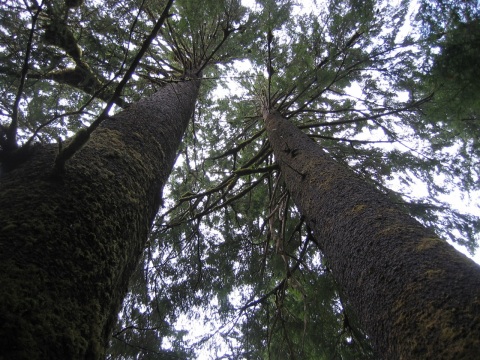
Along the banks of the Yakoun River, near where K’iid K’iyaas, the legendary Golden Spruce stood until its untimely demise in 1997. Every year the salmon come back to this essential river artery of Haida Gwaii. At least for now.

Medicine Bow: A tale of beauty and devastation
Late last week, as world leaders were again failing to make progress on the rising threat of climate change, I was hiking to the top of Medicine Bow Peak in Wyoming. An unusually wet June produced a stunning sweep of wildflowers high upon the 12,000-foot mountain:

Combating global climate change is a complicated matter, to say the least, but I suspect that most people, attendees of G-8 summits included, would view the imperative in a whole new light if they were to witness the ecological devastation hitting this breathtaking region of the Mountain West. The fallout can be seen in the lush forests ringing Medicine Bow and other majestic snow-capped ranges in the area and in nearby Colorado — in the bleak, sprawling signature of an ongoing bark beetle epidemic. Warmer winters and drought in recent years allowed the insect population to explode, bringing destruction to more than 1.5 million acres.
“By about 2012, beetles will have killed nearly all of the mature lodgepole trees in northern Colorado and southern Wyoming,” reports the USDA Forest Service, “affecting water flows and watersheds, future timber production, wildlife habitat, recreation sites, transmission lines and scenic views. Beetle-killed trees also present a fuels build-up situation that could result in catastrophic wildland fires. These events pose threats to homes and property and could cause adverse economic impacts to communities.”
According to Erik Molvar, a wildlife biologist in Laramie, the beetle infestations have been roaring on unabated because of climate change. “These infestations take place naturally on 20- to 40-year cycles,” he said in a news article early last year. “In the past, they’ve run their course until a bitterly cold winter took place. Studies show that you need a two-week cold snap at minus 20 degrees Fahrenheit to kill off the beetles. Nothing else works.”
For several years now, it hasn’t gotten cold enough.
The forests seen here in the distance from the top of Medicine Bow…

… could soon resemble these seen in this recent aerial photo, taken in northern Colorado, from the USDA Forest Service:

Some other forested areas I saw last week in the vicinity of Medicine Bow (especially at lower elevations that stay warmer) are already riddled with dead and dying trees. The friends I was with, who’ve been coming to the area for the last decade, described the accumulating damage in dramatic terms — some pristine expanses that existed just a couple of years ago won’t be seen again in our lifetime.
It’s hard to know how bad it might get (it’s already bad), or whether anything can actually be done to slow or stop this particular disaster. But it’s one stark example of what climate change can bring, and why we have to pay attention. Over the weekend Timothy Egan argued that Michelle Obama should throw her political weight behind America’s increasingly marginalized national parks. Egan’s perspective was more cultural than environmental, but from what I saw in Wyoming, there’s no lack of pressing reason on the latter front, either.
Or perhaps, as Emerson suggested in his famous essay on nature, what’s ultimately at stake is an essential interdependence:
“The tempered light of the woods is like a perpetual morning, and is stimulating and heroic. The anciently reported spells of these places creep on us. The stems of pines, hemlocks and oaks almost gleam like iron on the excited eye. The incommunicable trees begin to persuade us to live with them, and quit our life of solemn trifles.”
Sharp turn on Wall Street
My cover story for the July/August issue of Arrive is now riding the northeastern rails, a look at the nation’s economic crisis and the role of the financial media. CNBC’s Maria Bartiromo, the Wall Street Journal’s David Wessel and others ponder the end of days on Wall Street and what the American economy will look like on the other side of its most vicious hangover in decades.
CNBC has taken some big lumps this year for the behavior of some of its on-air personalities, perhaps deservedly so. But during a lengthy chat for the story earlier this year, after pushing past a bit of canned stuff, I found Bartiromo to be quite knowledgeable, engaging and forthright. And I happen to agree with her take on Jon Stewart’s big beatdown of Jim Cramer and CNBC back in March.
 Will America’s investment banking sector soon be a miniature of its turn-of-millennium self? (And would that be a good thing?) Who are the most deserving villains in the blame game? Read on… Meanwhile, during a quick ATM stop at a Chase bank branch yesterday I witnessed an exchange that seemed in some small way encouraging — perhaps an indication that America has started to move beyond the denial/anger stage, and into the acceptance/change stage.
Will America’s investment banking sector soon be a miniature of its turn-of-millennium self? (And would that be a good thing?) Who are the most deserving villains in the blame game? Read on… Meanwhile, during a quick ATM stop at a Chase bank branch yesterday I witnessed an exchange that seemed in some small way encouraging — perhaps an indication that America has started to move beyond the denial/anger stage, and into the acceptance/change stage.
A bank employee was walking out just as a long-time customer was walking in. The customer asked the bank employee if in the past few weeks it had gotten any easier to get a loan. (The specific type wasn’t clear, though it was obviously either a home mortgage or small business loan.) “No, it hasn’t gotten any easier,” the bank employee said, with a cheery smile. “As you know, they’re asking a lot more questions now.” The customer smiled back, unfazed, and headed into the bank, paperwork in hand.
Moonwalk for Mahmoud Ahmadinejad
The embattled Iranian regime couldn’t have dreamed up a better reprieve from scrutiny than the worldwide media frenzy over Michael Jackson’s death, only just getting underway.
How much Jackson coverage will be too much? (Whatever that is, we’re likely to find out.) His death is tragic but unsurprising given his condition in recent years. A great sadness for his family, friends and fans — and arguably a great relief, as the world can finally stop fixating on the downtempo horror show of misery and self-mutilation, and instead remember Jackson for the extraordinary music and artistry he gave, particularly in his earlier days.

Indeed, the postmortem coverage will be ceaseless for days to come, while Mahmoud Ahmadinejad’s sham of a reelection and attendant brutality recedes from the headlines. But what continues unfolding in Iran remains worthy of top billing. Prospects for the beginnings of rapprochement with the Obama administration now appear to be on ice. The regime is claiming the election was fraud-free. (The voting populations of various Iranian towns must have swelled overnight.) Clerics close to Ayatollah Khamenei are calling for dissidents to be punished ruthlessly and savagely. Veteran journalists anticipate that the country’s media lockdown will continue for a long time. (NBC News chief foreign correspondent Richard Engel: “We’re openly being called the instigators of a revolt.” More details here on the media crackdown.)
 Decentralized digital communications may become ever more critical to publicizing what’s transpiring inside Iran. As of Friday afternoon Michael Jackson commanded the top three slots for Twitter hashtags (#MJ’s; #RIP Mj; #michaeljackson), but Iran was still trending at fifth and sixth (#Iran; #iranelection). Also of note: The UK blogger whose Iran cyberwar guide mysteriously vanished last week is back online and has a second installment, an interesting rundown for tech and politics junkies alike. Meanwhile, this recently posted mash-up evokes the strange confluence of the historical moment, setting images from the Iranian election upheaval (some of them graphically disturbing) to Jackson’s controversial song “They Don’t Care About Us.”
Decentralized digital communications may become ever more critical to publicizing what’s transpiring inside Iran. As of Friday afternoon Michael Jackson commanded the top three slots for Twitter hashtags (#MJ’s; #RIP Mj; #michaeljackson), but Iran was still trending at fifth and sixth (#Iran; #iranelection). Also of note: The UK blogger whose Iran cyberwar guide mysteriously vanished last week is back online and has a second installment, an interesting rundown for tech and politics junkies alike. Meanwhile, this recently posted mash-up evokes the strange confluence of the historical moment, setting images from the Iranian election upheaval (some of them graphically disturbing) to Jackson’s controversial song “They Don’t Care About Us.”
Black clouds over Tehran
There will be blood — much more of it, if need be — was the implicit message from Ayatollah Khamenei at Friday prayers in Tehran. “Struggling on the streets after elections is not acceptable,” the Iranian Supreme Leader said. “If they do not stop these actions, then any consequences will be their responsibility.”

Khamenei emphasized that the Islamic republic would never “commit treason” by manipulating votes, that the country’s legal system does not allow vote-rigging. Mahmoud Ahmadinejad’s large margin of victory — supposedly by 11 million votes — proved that the election could not have been fixed, Khamenei said.
Many Iranians, and people around the world, understand that’s a lie. As Stanford University’s Abbas Milani noted on CNN Thursday night, numerous towns across Iran had reported vote totals for Ahmadinejad amounting to more than 100 percent of their resident populations.

But in Iran the fist, not the facts, likely will prevail.
 Neil MacFarquhar reports on the violence unleashed in Iranian cities at night since last Friday’s election, with the vigilante thugs known as Basijis beating, looting and sometimes gunning down protesters they tracked during the day. Says one Iranian exile who helped found the Revolutionary Guards during the 1979 Islamic revolution: “It is the special brigades of the Revolutionary Guards who right now, especially at night, trap young demonstrators and kill them.”
Neil MacFarquhar reports on the violence unleashed in Iranian cities at night since last Friday’s election, with the vigilante thugs known as Basijis beating, looting and sometimes gunning down protesters they tracked during the day. Says one Iranian exile who helped found the Revolutionary Guards during the 1979 Islamic revolution: “It is the special brigades of the Revolutionary Guards who right now, especially at night, trap young demonstrators and kill them.”
If mass protests continue, as seems almost certain, more violence will spill into broad daylight, whether or not any foreign media is left inside the country to document it.
UPDATE: The Times’ Lede blog has a source in Tehran describing the use of Twitter — apparently less instrumental in organizing street demonstrations, while “primarily being used to communicate with the outside world.”
Regarding prospects for greater violence and ultimate political outcome, Steve Clemons shares an interesting dispatch from “a well-connected Iranian internationalist” who has been in Tehran during the post-election unrest. The source describes witnessing young Mousavi supporters in the streets at night, fighting back by “hunting” Basijis. He describes them as agile “militia style” groups, including “a surprising number of girls.”
 Leave a comment
Leave a comment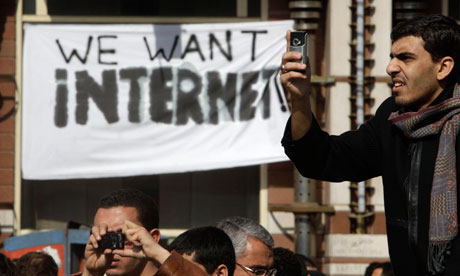
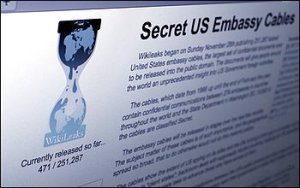


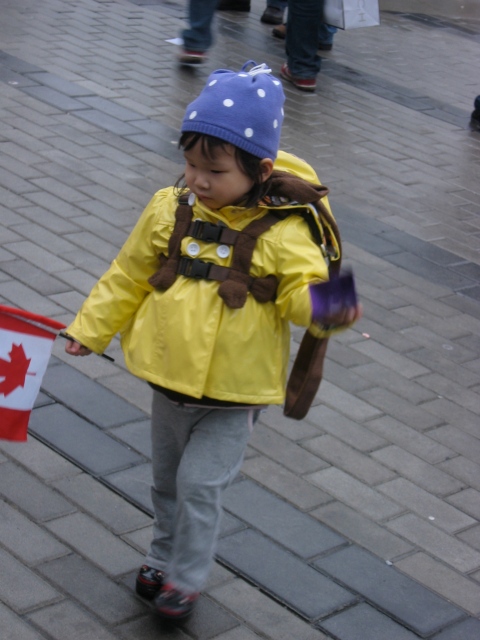

You must be logged in to post a comment.